#OCLCelebratesJuneteenth
Text
Oberlin and the Underground Railroad
This week, the Oberlin College Archives and Libraries will celebrate Juneteenth. Juneteenth is an annual holiday held on June 19, dating back to 1865 when Union Major General Gordon Granger traveled to Galveston, Texas to announce the Civil War had ended and that enslaved individuals were free. Texas had very little Union presence and the Emancipation Proclamation was not easily enforced, and most enslaved blacks had no idea that they were actually freed two and a half years earlier.
Lorain County, Ohio was an important geographic area for fugitive slaves traveling the Underground Railroad, due to its location on Lake Erie which was a direct route into Canada. Many citizens of Oberlin, including those involved at Oberlin College, held strong anti-slavery convictions which led them to assisting escaped slaves through the town and further north to Lake Erie.

“The Confidence Game,” drawing by Charles H. Churchill, depicting people decoying slave catchers into the woods on the right, while a fugitive slave escapes to the left, near Oberlin, Ohio, 1850s.
Some individuals stayed in Oberlin due to its accepting nature and how welcome they felt in the community. Oberlin and its citizens provided the promise of safety and sanctuary, and a life of peace. No fugitive slave traveling through Oberlin on the Underground Railroad was ever caught and returned to slavery.
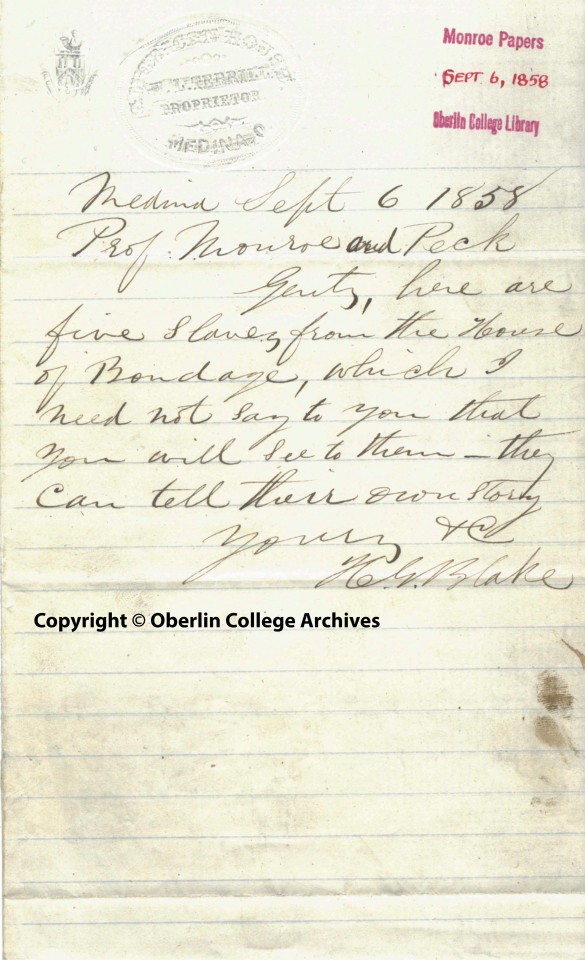
A “ticket” from the Underground Railroad, sent to Oberlin professors James Monroe and Henry E. Peck by H.G. Blake:
Medina Sept 6 1858
Prof. Monroe and Peck
Gents, here are five slaves from the House of Bondage, which I need not say to you that you will see to them—they can tell their own story
Yours &c
H.G. Blake
The Oberlin-Wellington Rescue
On September 13, 1858, escaped slave John Price, who was residing in Oberlin at the time, was arrested under the Fugitive Slave Act of 1850, and taken to nearby Wellington to be boarded on a train to Kentucky, and ultimately back to slavery.
Citizens of Oberlin, including college faculty and students, rushed to aid John Price, who was being held at the Wadsworth Hotel. The group of rescuers stormed the hotel where they found Price in the attic. No shots were fired and no one was reported to be injured during the rescue.

The Wadsworth Hotel and Tavern, Wellington, Ohio, n.d.
Oberlin citizen Simeon Bushnell, a clerk and printer, drove the carriage back to Oberlin with John Price. Price was then hidden in Oberlin College professor and future president James Harris Fairchild’s house. Fairchild had been away eariler in the day and had not participated in the rescue.
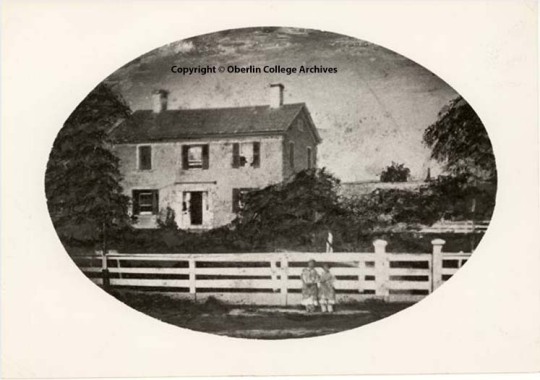
The home of James H. Fairchild on Professor Street, 1850s
Thirty-seven rescuers were later indicted for violating the Fugitive Slave Act of 1850. Out of those rescuers, only twenty of them were actually jailed in the Cuyahoga County jail. Simeon Bushnell, Professor Henry E. Peck, and twelve free black men, including abolitionist Charles Henry Langston (grandfather of the poet Langston Hughes), were among those jailed.
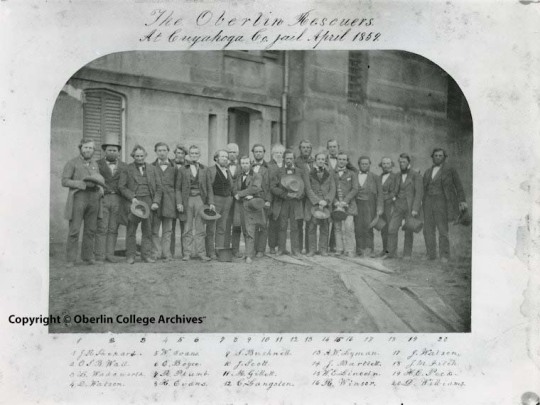
The Oberlin Rescuers at the Cuyahoga County Jail, April 1859
(Charles Langston is pictured near the middle of the photo with a hat at his chest)
Newspaper reports state that hundreds of people visited the rescuers in jail, including the families of the rescuers and supporters of the anti-slavery cause. Most importantly, politicians visited the rescuers, and brought the issue of slavery into a more political standpoint. This would help push slavery issues into the spotlight for the upcoming presidential campaigns.
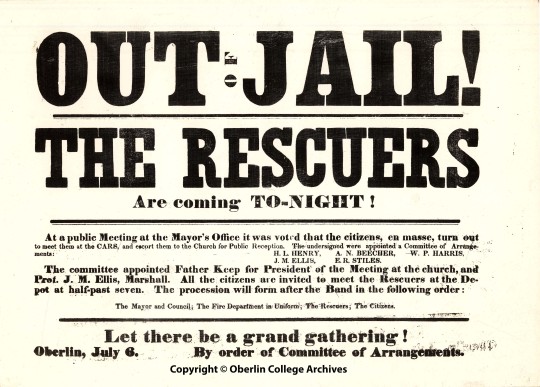
Broadside announcing the rescuers return to Oberlin after their release from jail, 1859
Due to the efforts of the rescuers, escaped slaves could believe in the town and citizens of Oberlin to keep them safe from a country that was not always safe for them. Oberlin continued to be a reliable stop on the Underground Railroad until around 1861-62, when the Fugitive Slave Act was overturned.
#oberlin#Oberlin College#Oberlin College Archives#oberlin college libraries#oberlin wellington rescue#juneteenth#OCLCelebratesJuneteenth
14 notes
·
View notes
Text
Gordon Parks & Kendrick Lamar Team Up

youtube
Rapper Kendrick Lamar’s music video for ELEMENT – a single off his album DAMN – features beautiful, often haunting imagery drawn from the work of 20th century photographer Gordon Parks. Check it out below!
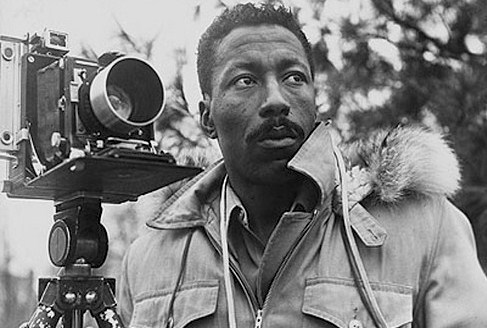
Gordon Parks (1912-2006), a self-taught, multi-talented artist, was a prolific author, poet, photographer, musician, composer, and filmmaker.
A famous pioneer among black filmmakers, Parks was the first African American to produce and direct major motion pictures. His films related the experience of slaves, struggling black Americans, and he created the "blaxploitation" genre. His is best known as the director of the 1971 film Shaft.
Parks was also the first African American photographer to work for the Farm Security Administration (FSA) and for the Office of War Information (OWI), as well as for Life and Vogue magazines. He is best remembered for his iconic photos of poor Americans during the 1940s, and for his photographic essays for Life magazine. The themes of civil rights, poverty, and the experience of Black Americans are found throughout his work.
The following portraits taken by Parks are referenced in the ELEMENT. video.

Boy with June Bug, 1963
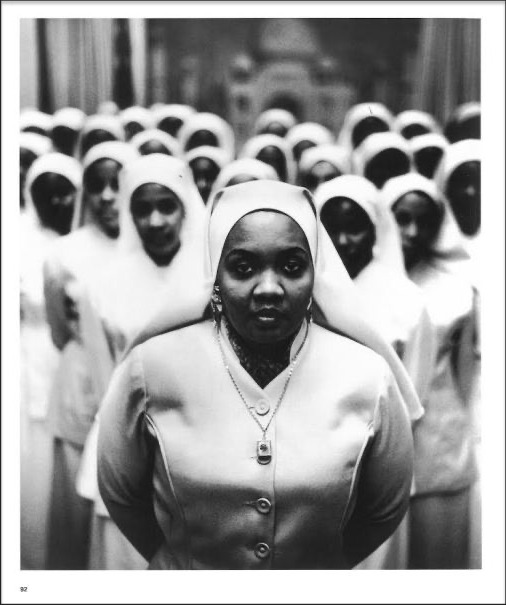
Ethel Shariff in Chicago, 1963

Untitled, 1956
The Allen Memorial Art Museum has a photograph by Gordan Parks:

Portrait of a Workman, Ben Wright. 1944
Want to learn more? Check out the many books about Gordon Parks in the Oberlin College Libraries.
7 notes
·
View notes
Text
Kopo Oromeng '18, PhD candidate, shares recollections of OC and POC in STEM
We're celebrating Juneteenth with a look at a few* Black women in science and medicine who began their careers at Oberlin.
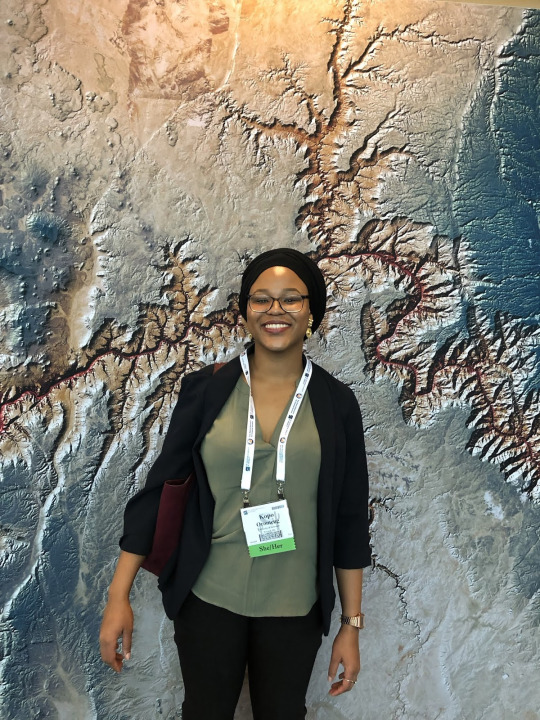
(Oromeng at GSA 2019 Conference)
Kopo Oromeng’18 (Economics and Geology)
MS in Hydrology, University of Delaware ’20
PhD candidate in Geography & Spatial Sciences, University of Delaware
At Oberlin
: Oberlin gave me a very wholesome undergrad STEM experience. I learned to be the kind of scientist who interrogated social structures, wrote well, and engaged in community service. As a Bonner Scholar, I spent my time at the Oberlin Public Library working at the children’s desk. My position challenged me to make science fun for pre-k and first graders (which requires a lot of free toys and glitter), but I also noticed that many younger children of color at Oberlin struggled with reading and writing. As a double major in Economics, I took classes in Urban and Development economics along with Geology classes.
Advice
The first time I met a black female geologist was at the
National Association of Black Geoscientists. She was an Obie and would later mentor me over a summer research internship at the University of Arizona. Seeing someone who looked like me excel in a STEM field validated my aspirations. My advice to current Oberlin students is to seek out alumni, connect with us, and we’ll meet you wherever you are because we’ve been there too.
We, of course, need more people of color in STEM now more than ever before. We need Black data and artificial intelligence scientists, physicists, marine biologists, mathematicians, and so many more scientists who can design systems that do not exclude people who look like us, and who will contribute to science that challenges the status quo and changes the way we understand the world.
--contributed by Kopo Oromeng at our invitation, with minor editing
*Please look for the other Black women in science and medicine we will profile this Juneteenth: Matilda A. Evans, MD; Jé Judson, MPH; Lauren V. Wood, MD; in the Science Library's Instagram,Twitter and posts. Thank you!
3 notes
·
View notes
Photo
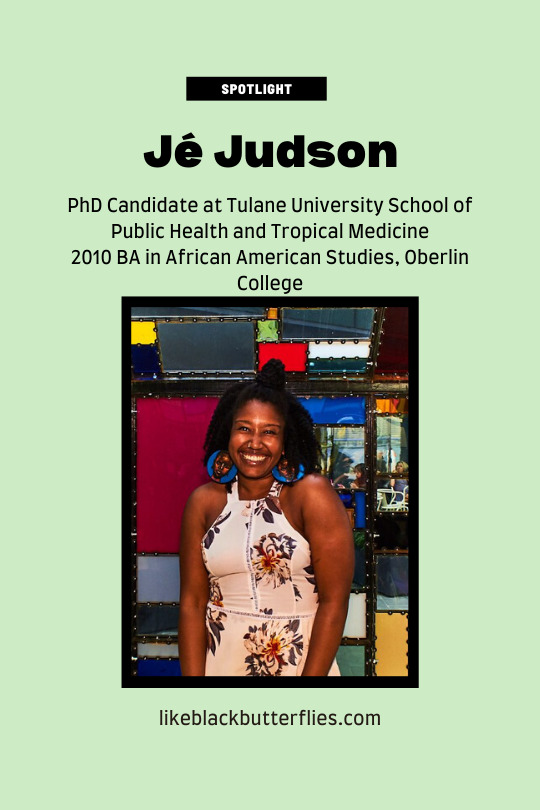
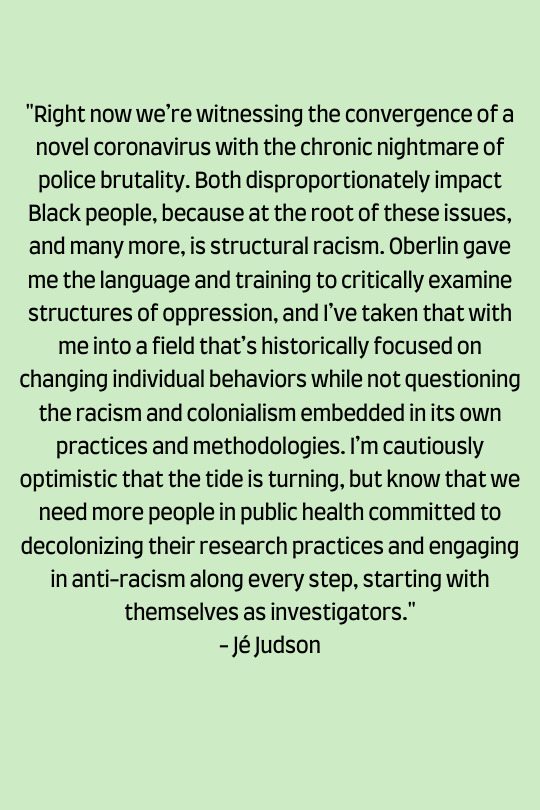
Juneteenth celebration! The Science Library continues to honor the accomplishments of Oberlin College educated Black medical professionals and scientists past, present and future.
Jé Judson ‘10, PhD candidate in Public Health (Tulane University School of Public Health and Tropical Medicine), shared her thoughts about our current juncture in time, at the intersection of a pandemic and civil action against police brutality. Thank you, Jé!
“Right now we’re witnessing the convergence of a novel coronavirus with the chronic nightmare of police brutality. Both disproportionately impact Black people, because at the root of these issues, and many more, is structural racism. Oberlin gave me the language and training to critically examine structures of oppression, and I’ve taken that with me into a field that’s historically focused on changing individual behaviors while not questioning the racism and colonialism embedded in its own practices and methodologies. I’m cautiously optimistic that the tide is turning, but know that we need more people in public health committed to decolonizing their research practices and engaging in anti-racism along every step, starting with themselves as investigators.”
#oclcelebratesjuneteenth#ocjuneteenth#juneteenth2020#oberlin college#oberlin college libraries#blacks in stem#poc in stem
0 notes
Text
Early Black Graduates of Oberlin College
The Oberlin Collegiate Institute (later Oberlin College) was founded on groundbreaking values in 1833 when it became the first coeducational institution in the United States. Two years later in 1835, Oberlin cemented its progressive standards when the board of trustees adopted a policy allowing all students to receive an education “irrespective of color.”

George Boyer Vashon (1824-78,), born in Carlisle, PA, was Oberlin College’s first black graduate, receiving the A.B. degree in 1844. After finishing his studies, he returned to Pennsylvania to practice law, but was not allowed to be admitted to the bar because of his skin color. Vashon was admitted to the New York state bar in 1848, becoming New York’s first black lawyer. Vashon also had a notable career in education. He was a language teacher in Haiti, president of Avery College in Pittsburgh, PA, Howard University’s first black professor, and professor of mathematics and ancient and modern languages at Alcorn University.

Mary Jane Patterson (1840-94), was born in Raleigh, NC and later moved to Oberlin, OH with her family. She then attended Oberlin College and became the first black woman to ever receive an A.B. degree in 1862. After leaving Oberlin, Patterson dedicated her life to education. She was the assistant to fellow Oberlin graduate Fanny Jackson Coppin at Philadelphia’s Institute for Colored Youth (now the Cheyney University of Pennsylvania), and then taught at Washington D.C.’s Preparatory High School for Colored Youth (now Dunbar High School). She served as the school’s first black principal, and under her leadership the high school gained enrollment and added a teacher training program. Patterson continued to teach at the high school until her death. She also was very active in other organizations for people of color in D.C., including assisting the elderly, rescue work, and teaching organizations.
Three Trailblazing Oberlin Women
The Oberlin College Class of 1884 produced many talented and remarkable graduates. Included in this class are three black women: Mary Church Terrell, Anna Julia Cooper, and Ida Gibbs Hunt, who made their mark on the world in education, women’s rights, and became lifelong colleagues and friends.

Mary Eliza Church Terrell (1863-1954) was born in Memphis, TN and later moved to Oberlin, OH with her family, where she attended high school and then Oberlin College. After her education at Oberlin, she taught at Wilberforce University, and then studied in Europe for two years, becoming fluent in Italian, French, and German. When Terrell returned to the United States, she shifted her focus from her career in education to social activism. She became the first president of the National Association of Colored Women, fought for black women’s suffrage when the National American Women Suffrage Association was more focused on white women, and stood on picket lines to fight for the integration of businesses and schools. The Oberlin College main library is now named for Terrell, and her illustrious career and achievements can be studied at our digital exhibit.

Ida Alexander Gibbs Hunt (1862-1957) was born in Victoria, British Columbia, and later moved to Oberlin, OH. Hunt began her career after college as a teacher, but had to leave her position after her marriage in 1920, as married women were not seen as appropriate teachers for young people. She shifted her focus to worldwide peace issues and racial and gender equality. Hunt assisted W.E.B. DuBois organize Pan-African Congresses, and served as the primary French translator of the 1919 Paris Pan-African Congress, and co-chaired the 1923 London Pan-African Congress. She also organized the first black chapter of the Young Women’s Christian Association (YWCA) and served on the board of the Phyllis Wheatley YWCA.

Anna Julia Haywood Cooper (1858-1964) was born into slavery in Raleigh, NC. After completing her studies at Oberlin, Cooper moved to Washington, D.C. and taught Latin at the M Street High School. She left her position there due to her belief that black students should be able to have a classical education, instead of only being offered trade schooling, but later returned. Cooper was a speaker at the World’s Congress of Representative Women in 1893, and spoke at the first Pan-African Congress in 1900. She received a Ph.D. from the Sorbonne in 1924 (at the age of 65), which made her only the fourth black woman to hold a doctorate at that time. Cooper then became president of Frelinghuysen University, a school founded in D.C. to provide black students older than public school age access to schooling.
These are just brief glimpses into the fascinating lives of these Oberlin College alums. For further information on each of them, you can search the African American Registry, or contact us for holdings in the Oberlin College Archives.
#Oberlin College#Oberlin#Oberlin College Archives#oberlin college libraries#black history#juneteenth#OCLCelebratesJuneteenth#OCJuneteenth
13 notes
·
View notes
Text
Juneteenth and Oberlin
Celebrations supporting the rights of blacks have been important to the Oberlin community since its founding.
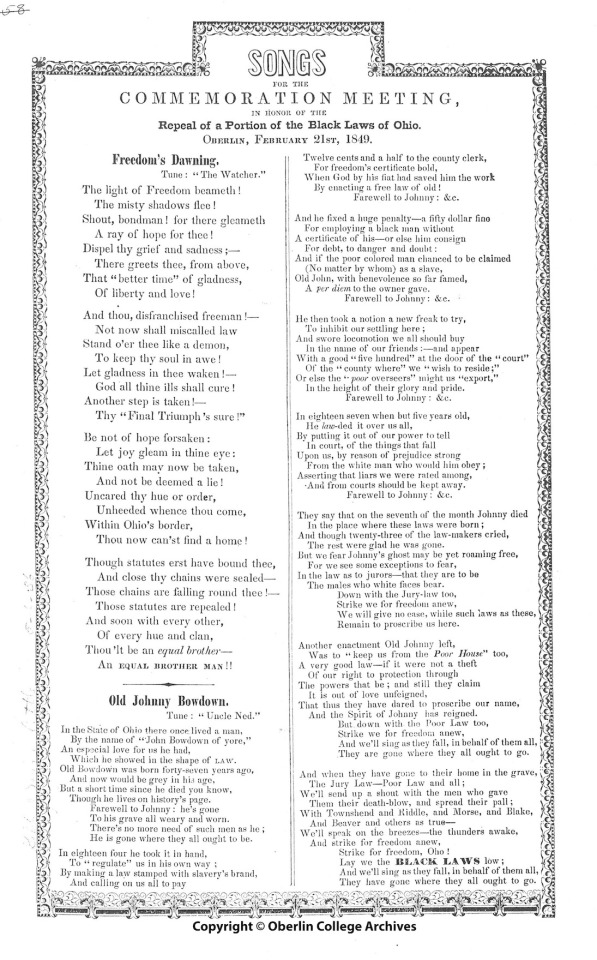
In January 1849, the Black Laws of 1807 discouraging blacks migration to Ohio were largely repealed. These laws included requiring blacks to have proof that they were indeed free and needed two people to guarantee a surety of $500 that they would maintain good behavior. Dr. Norton S. Townsend, a trustee of Oberlin College was instrumental in assisting in the repeal of these laws. A celebration of songs, some pictured in the program above, was held in February 1849 commemorating the repeals.

In the summer of 1992, the Oberlin community began celebrating the history of its black residents, in conjunction with the existing Oberlin Heritage Days festival, organized by Adenike Sharpley, former artist-in-residence and director of the Dance Diaspora at Oberlin College. In 1995, the festival added the official Juneteenth celebration. Oberlin’s history of abolitionism, its role in the Underground Railroad, and its promise of freedom for all make it a city significant to the Juneteenth holiday.
On June 8, 2004, the Oberlin City Council passed a resolution that Juneteenth be recognized as an official day of commemoration and celebration, and Juneteenth Oberlin was incorporated.
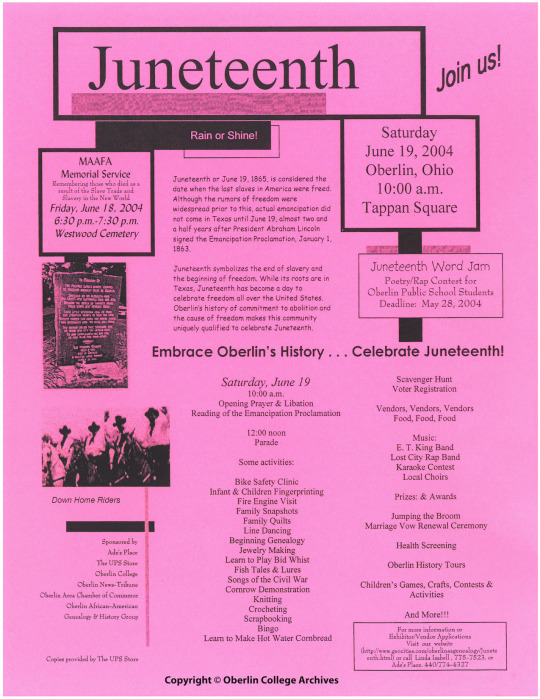
Every year, Juneteenth is celebrated with many events throughout Oberlin. The Emancipation Proclamation is read, artwork is displayed, prayers and picnics are held, educational activities are available for children and families, and remembrances for the enslaved are held at Westwood Cemetery.

Commemorative fan from Juneteenth, 2006
Lee Howard Dobbins Memorials
One recurring event during Oberlin’s Juneteenth celebrations is the remembrance of Lee Howard Dobbins. Dobbins was a four year old black enslaved child following the Underground Railroad to Canada to freedom, when he became so ill that the woman caring for him could not bring him any further. A family in Oberlin took Dobbins in, and he died from consumption only a few days later.
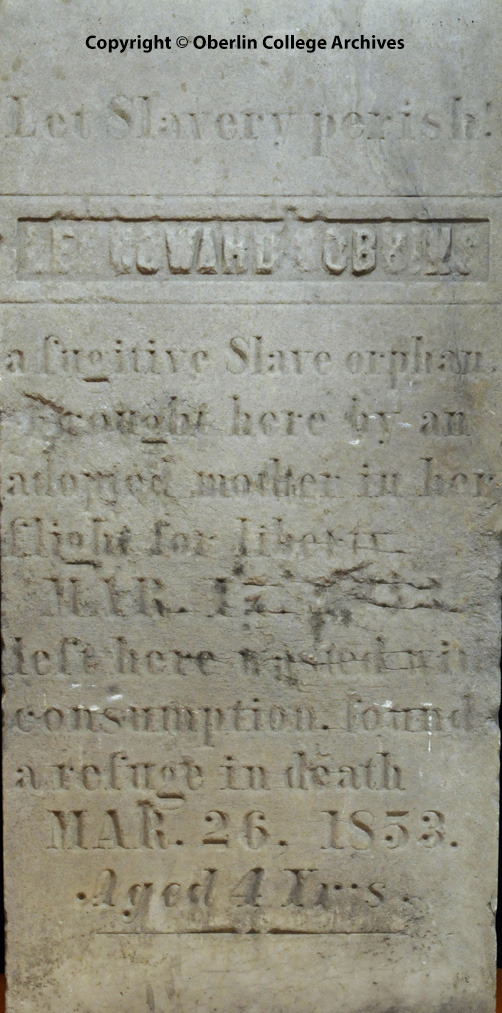
Lee Howard Dobbins’ Tombstone
Let Slavery perish!
Lee Howard Dobbins
a fugitive slave orphan,
brought here by an adopted mother in her
flight for liberty,
MAR. 17, 1853
left here wasted with
consumption. found a refuge in death
MAR. 26, 1853.
Aged 4 Yrs.
A funeral was held for Dobbins at First Church, where it is said over 1000 people attended. The Oberlin citizens raised funds and erected a tombstone for Dobbins, and he was originally buried in the Professor Street Cemetery. The original tombstone is now held in the Oberlin College Libraries, and a new memorial for Dobbins is now standing at the front of Westwood Cemetery. Remembrances and prayers are held at this memorial for Dobbins and other former slaves during Juneteenth.
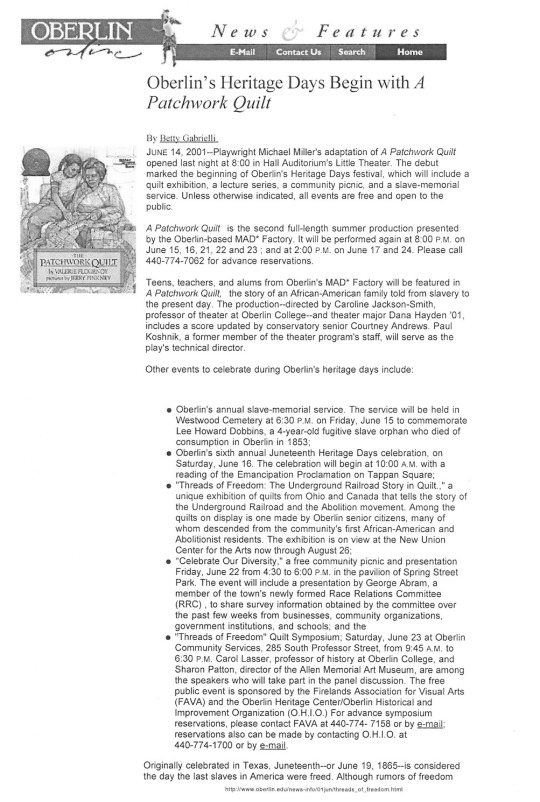
First page of article detailing events for the Juneteenth, 2001 celebration
To learn more about the history of Juneteenth, the Emancipation Proclamation, and further Oberlin influences in the history of ending slavery, check out Juneteenth—The “Extinction” of Legalized Slavery in America, a blog post written by Ron Gorman, former Oberlin Heritage Center docent and friend of the Oberlin College Archives, in 2015 for the 150th anniversary.

Program commemorating the 150th anniversary of Westwood Cemetery coinciding with Juneteenth, 2014
While this year won’t have the typical in-person Juneteenth events due to the COVID-19 pandemic, remembrances and events will be happening virtually through Oberlin College, the Oberlin College Libraries, and the Oberlin Heritage Center.
#Oberlin#Oberlin College#Oberlin College Archives#oberlin college libraries#OCLCelebratesJuneteenth#OCJuneteenth#juneteenth#anti-slavery
6 notes
·
View notes
Text
An Allen Work and an Art Book: Willie Cole

You remember works by Willie Cole.
Cole art transforms the shapes of everyday objects. His two works in the Allen collection use the shape and patterns of irons. In Proctor Silex (Evidence and Presence) – which fleshed out the Allen's award winning Afterlives of the Black Atlantic – Cole scorches his canvas with patterns evoking slave ships and African masks. The scorched pattern returns in his Man, Spirit, Mask a triptych.
Proctor Silex (Evidence and Presence)
Willie Cole (1989)
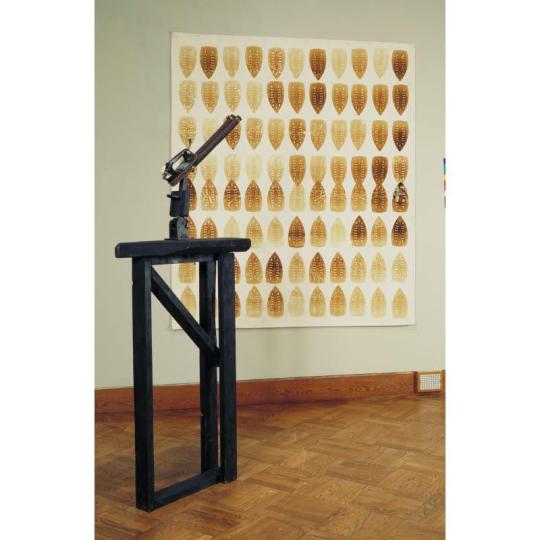
Cole’s influence is evident in the work of Tatana Kellner. Kellner is a book artist and co-founder of Women’s Studio Workshop in Rosendale, NY.
Iron was originally an installation where an automated iron reveals text as it irons out a white dress shirt. Kellner’s book Iron examines the history of domestic labor and immigration, while the images document the technological progress of ironing appliances (patents included). Printed in invisible ink, the viewer reads the book by ironing the pages. You can see Iron in the Clarence Ward Art Library collection.
Iron
Tatana Kellner
[Rosendale, New York]: Women's Studio Workshop, [2008]
Clarence Ward Art Library, N7433.4.K456 I76 2008

Want to learn more?
Anxious objects: Willie Cole's favorite brands
Patterson Sims
Montclair, N.J.: Montclair Art Museum, [2006]
Clarence Ward Art Library, NB237.C64 A4 2006

An object maker, musician, poet, and performer, Willie Cole is an artist with remarkably diverse art-making skills and a formidable imagination. Best known for his assemblage, mixed media sculptural works, and prints, Cole liberates and aggrandizes everyday artifacts, including irons, ironing boards, hairdryers, high-heeled shoes, lawn jockeys, bicycle parts, and other discarded domestic appliances and hardware and transforms them into powerful and iconic art works.
4 notes
·
View notes
Link
Rowena Jelliffe, a pioneer in the area of interracial theater, president of the Oberlin Women's Suffrage League, and Oberlin College alumna, together with her husband, Russell Jelliffe (also an Oberlin alumnus), founded a settlement house in 1915 that would later become Karamu House in 1941.
Today, Friday, June 19, 2020, on Juneteenth, the commemoration of the ending of slavery in America, Karamu House—the country’s oldest African American producing theatre—will debut Freedom on Juneteenth, an original theatrical production and artistic response to the recent murders of Black Americans through music, dance, and spoken word.

#ocjuneteenth#oclcelebratesjuneteenth#juneteenth2020#karamu house#Oberlin College#Oberlin College Libraries
2 notes
·
View notes
Photo
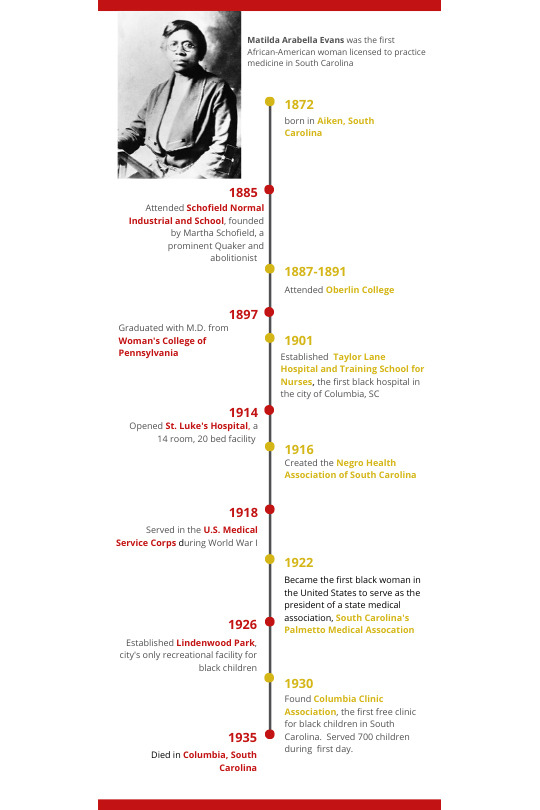
A Woman to Know: Matilda Arabella Evans, MD.
Dr. Evans attended Oberlin College on a scholarship for nearly four years and left before graduating in 1891 to begin an extraordinary medical career, as seen in the timeline infographic above. Learn more about the first African American woman licensed to practice medicine in South Carolina, a one-time Obie who made a difference for good. Celebrate Juneteenth and the liberating force of education. @oberlincollegelibraries
#oclcelebratesjuneteenth#ocjuneteenth#oberlin college#oberlin college libraries#blacksinstem#poc in stem#juneteenth2020
0 notes
Photo

Dr. Lauren V. Wood, Chief Medical Officer, PDS Biotechnology, graduated from Oberlin College in 1980.
We are happy to profile Oberlin alumna Dr. Wood as we celebrate Juneteenth. Dr. Wood worked with Dr. Anthony Fauci early in her career, investigating HIV-specific cellular and humoral immune responses. Along the way, she became a captain in the U.S. Public Health Services Commissioned Corps and was a researcher in the National Institutes of Health (NIH). A bit of advice from Dr. Wood to those contemplating their career path: “If you want to see miserable people in life, look at the people who didn’t pursue what was really in their hearts to do.” [video from NIH]. @oberlincollegelibraries
#oclcelebratesjuneteenth#ocjuneteenth#oberlin college libraries#oberlin college#blacksinstem#poc in stem#juneteenth2020
0 notes
Text

“Originally posted Jun. 19, 2020″
Black Creative Fire: Edmonia Lewis and Neoclassicism
clarencewardartlibrary:
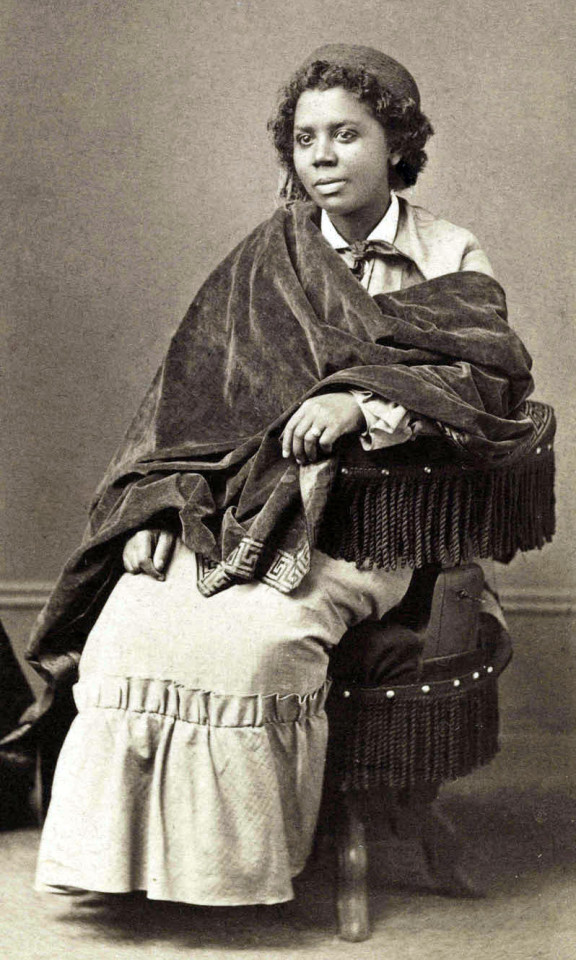
Chicago, 1987. The Forest Park Historical Society is perplexed by a curious-looking woman made of marble. Beneath the chipping and grease is a woman lying in a tremendous chair with two sphinx heads on the side. Her body is seated calmly, but her face is writhing in pain from what seems to be a bite from a small snake in her right hand. The Society is stunned by the beauty, deep sadness, and mourning of the marble woman, but have no idea where she came from. The only clue to her origins is an inscription on her side:
E. LEWIS ROMA
Keep reading

(via clarencewardartlibrary)
83 North Main Street, Oberlin, OH, 44074. 440-775-8635
#Juneteenth2020 #OCJuneteenth #OCLCelebratesJuneteenth
4 notes
·
View notes